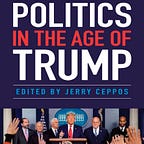Trump’s gifts to journalists of color
By Jerry Ceppos
When I asked 24 top Washington journalists to write about their experiences covering the Trump Administration, I knew that I’d get some surprises.
For example, McKay Coppins of The Atlantic wrote about the terror campaign that Trump unleashed after disliking a story: “The sheer volume of the smear campaign was impressive. Scrolling down Breitbart’s home page yielded seven different stories related to my betrayal of ‘Mr. Trump.’’’
Mark Leibovich of The New York Times remembered President Trump hounding him for a profile in the Times Magazine. After it appeared, Trump told him, “You treated me very badly.”
Quint Forgey, a young reporter at POLITICO, asked, “Was it always like this?”
But the essays that bothered me most were from journalists of color. For example, Jesse J. Holland, formerly of The Associated Press, explained that during the Obama Administration life had changed for the better — briefly:
“Just as the president wasn’t the Black president — but THE president — African Americans seemed to be elevated in the industry from being just Black journalists to JOURNALISTS, seen finally as equal to our colleagues.”
Then President Trump was elected. “And something changed…. (W)e were just Black journalists again.”
Mary C. Curtis, a CQ Roll Call columnist and host of its “Equal Time” podcast, wrote, “Never have I felt as vulnerable as I had at any Trump rally…. When the president trained laser-focused attacks on the press pen, colleagues who were not Black or brown were covered in a sort of camouflage as I was laid bare.”
Fernando Pizarro, then of Univision, wrote of the dismantling of the office that handled Spanish-language media, a signal that the Trump Administration didn’t really care about reaching Hispanic viewers.
The essays have turned into a book, “Covering Politics in the Age of Trump,” published July 14 by the LSU Press.
Because the book finally was published, this seemed a good time to ask the three journalists of color and some of their colleagues if things have improved in the first six months of the Biden Administration.
The answer unanimously was yes — but. Pizarro noted that the White House’s Spanish-language website is up and running. There now is a director of Hispanic media and there are a variety of Spanish-speaking communications people in the White House and the agencies. But he said that some Hispanic reporters, particularly foreign correspondents, are left out of important announcements on immigration and other issues.
Curtis told me about a couple who recognized and confronted her at a gym as the wife screamed, “70 million people voted for Trump.” Both later apologized, but that experience and others were a warning when she is recognized: “For two seconds, I hold my breath.” Curtis said “it would be naïve to say we have a different president and things have changed. It’s never over.” But she, too, sees “a calmness in the country. People are not tweeting every day.”
Holland finds “a sense of a return to normalcy” even if the Biden Administration, like every other one in our history, doesn’t “think of the press corps as their friend.”
Juan Castillo, editorial-page editor of the Austin American-Statesman, summarized everyone’s thoughts: “My sense is that it is better. I think what happened with Trump was extraordinary, the way he treated journalists of color…. These journalists of color felt like they were not treated as equals. I think that’s all that journalists of color want, a fair shot to do their jobs.”
After a year of working on the book and stewing about the intractable problems of the Trump Administration, I left unfulfilled, wondering if things ever would get better.
Then, I talked to two journalists of color who believe that the Trump Administration triggered positive changes.
Long-time journalist and educator Maggie Rivas-Rodriguez said “one thing that Trump forced us to do” was to lead “some really neat conversations” in the classroom about media and politics. The situation caused a lot of journalists, even outside of the classroom, “to think more deeply about what we’re doing.”
Joie Chen, who was a CNN anchor and covered the White House and Capitol Hill for CBS, saw another unintended gift from Trump:
“The most positive thing you can say about the Trump Administration is that it exposed some of these fault lines that were rather hidden. If you were thoughtful, you would have recognized that the White House press room has been predominantly white for a long time and that journalists of color often have been marginalized…. A lot of the racism of the White House and of the Washington press corps was not on the surface until we reached the Trump Administration.”
But Chen also sees a challenge in the new recognition that the Washington press corps has not been diverse: “In today’s environment, what we’ve learned is the value and importance of bringing your identity and your diversity into coverage. So now the question is how do you balance that? I don’t know what the answer is, but this is really that moment when we are trying to decide how much of yourself do you bring to the coverage. How do you balance that, or should you even try?”
Given a choice between the question of bringing racial and ethnic identities to reporting and dealing with a formerly all-white, mostly male Washington press corps, I’ll settle for that tough first question.
Order “Covering Politics in the Age of Trump” at https://amzn.to/3iRfGG2
Jerry Ceppos was executive editor of the San Jose Mercury News and vice president for news of Knight Ridder. Later, he was dean of the Reynolds School of Journalism at the University of Nevada, Reno, and of LSU’s Manship School of Mass Communication, where he still teaches.
